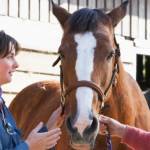Linking Hindgut Health in Horses with Nephrosplenic Entrapment

Nephrosplenic entrapment of the large colon remains a common cause of recurrent colic in horses.
“Nephrosplenic entrapment occurs when the left dorsal colon, which is a free-floating structure within the abdomen, becomes trapped in the nephrosplenic space. This is a space within the abdomen formed by the left kidney, nephrosplenic ligament, edge of the spleen, and the body wall,” described Catherine Whitehouse, M.S., a nutrition advisor for Kentucky Equine Research.
Colic due to nephrosplenic entrapment recurs at a rate of approximately 3-23%. While the underlying causes have not been completely identified, colonic motility dysfunction, accumulation of gas in the colon causing it to deviate upward, and a deep nephrosplenic space are all believed to contribute to recurrence rates.
“Diet is thought to contribute to colonic motility dysfunction and gas accumulation in the large colon,” said Whitehouse. Feeding meals, for example, of hay and grain pellets can dramatically increase the amount of fluid suddenly entering the large colon following that meal*. This excess fluid can place horses at risk of developing severe colonic distension, potentially leading to colonic displacement (and nephrosplenic entrapment) or volvulus, when the intestine twists.
Surgery to close the nephrosplenic space can be performed to minimize recurrence and has been performed on many horses since first described in 2001. Interestingly, despite its widespread use and availability, limited data exist that show whether or not the procedure has lasting benefits. To investigate this, one group of veterinary researchers from the University of Liege, Belgium**, reviewed medical records from colic cases admitted to their hospital between 2004 and 2016.
The following data were generated:
- Of the 2,498 colic cases presented to their hospital, 156 (6.2%) were diagnosed with left dorsal displacement of the left colon (LDDLC);
- Of the 156 horses with LDDLC, 84 (54%) were treated medically and 72 (46%) underwent surgical closure of the nephrosplenic space;
- Horses with a closed nephrosplenic space had a significantly lower rate of recurrent colic compared to those that retained their nephrosplenic space; and
- Owner satisfaction was 90% following closure of the nephrosplenic space, primarily due to either the reduction or absence of colic signs and the well-being of their horse. Some owners even noted an improvement in performance following closure.
“Some horses that underwent closure of the nephrosplenic space still suffered colic due to reasons other than LDDLC. Nonetheless, the data confirm that closure of the nephrosplenic space, which can be achieved using a minimally invasive surgical approach, reduces the risk of colic and should be considered in horses with persistent or recurrent colic,” Whitehouse summarized.
To maximize the health of your horse’s large colon to help avoid recurrent colic, offer a hindgut buffer such as EquiShure, a timed-release hindgut buffer.
“Maintaining a stable pH in the hindgut will support the intestinal microbiome, which plays an integral role in fermentation, energy production, and the overall health of the horse,” Whitehouse said.
*Blikslager, A.T. 2019. Colic prevention to avoid colic surgery: A surgeon’s perspective. Journal of Equine Veterinary Science 76:1-5.
**Arévalo Rodríguez, J.M., S. Grulke, A. Salciccia, et al. Nephrosplenic space closure significantly decreases recurrent colic in horses: A retrospective analysis. Veterinary Record. In press.








